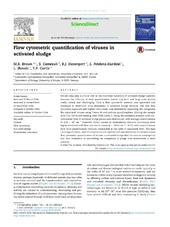Flow cytometric quantification of viruses in activated sludge
Brown, Matthew; Camézuli, Stella; Davenport, Russell J.; Petelenz-Kurdziel, Elzbieta Anna; Øvreås, Lise; Curtis, Tom
Peer reviewed, Journal article
Published version

Åpne
Permanent lenke
http://hdl.handle.net/1956/11804Utgivelsesdato
2015-10-18Metadata
Vis full innførselSamlinger
Originalversjon
https://doi.org/10.1016/j.watres.2014.10.018Sammendrag
Viruses may play a critical role in the microbial dynamics of activated sludge systems; however the difficulty of their quantification makes long term and large scale studies costly, timely and challenging. Thus a flow cytometric protocol was optimised and employed to determine virus abundance in activated sludge samples. The best flow cytometry signature and highest virus count was obtained by separating the indigenous floc-associated viruses using Tween 80 and sodium pyrophosphate, diluting the sample with Tris–EDTA and staining with SYBR Green II. Using the optimised protocol viral concentrations from 25 activated sludge plants were determined, with average concentrations of 2.35 × 109 mL−1 observed. Direct counts by transmission electron microscopy were highly correlated with flow cytometric counts (p = <0.05 and r2 = 0.77), with concentrations from both quantification methods comparable at the order of magnitude level. The high counting efficiency, ease of preparation and rapidity and reproducibility of analysis makes flow cytometric quantification of viruses in activated sludge ideal for routine investigation and thus invaluable in unravelling the complexity of phage host interactions in such systems.
